

Patient Perspectives on a Bilingual Online Patient Portal in a Predominantly Spanish-Speaking Safety Net Population Alejandro Ochoa AltaMed Health Services, Inc. Los Angeles, CA
Introduction • The utilization of patient portals (PP) has been associated with positive clinical outcomes and increased patient satisfaction [1]. • Patient-identified benefits include preferring to discuss sensitive issues, decreasing unnecessary clinic visits, and allowing for more frequent communication with their provider [4]. • However, decreased PP enrollment rates have been associated with groups that are of lower income, lower educational attainment, and ethnic minorities [2,3]. • Its unknown if a “digital divide among under -resourced communities limits their use of a PP, thereby worsening their health disparity status.
Methodology • In conjunction with the implementation of an online PP in June 2014, primary care patients completed a 37- item survey administered during a face-to-face interview. This survey was conducted during June and July 2014 at AltaMed Medical Group in Commerce, CA. • Survey domains included computer/Internet access and literacy, barriers and facilitators to patient portal adoption, and portal preferences. • Patients were eligible if they were 18 years of age or older, and were fluent in English or Spanish. Of all eligible patients approached (n = 488), 400 agreed to participate (82% response rate).
Results Technology Access & Literacy • Participants were primarily Latino, Spanish-speaking, and had a high school education or less. • The majority of patients had computer access (65.8%), Internet access (78.3%), a current email account (66.0%), and a smartphone (70.5%). • However, a “digital divide” exists, with patients >40 years of age, Spanish -speaking, with a high school education or less, and an annual family income of <$10,000 having significantly less technology access. Barriers & Benefits to PP Adoption (Figure 1) • Barriers: about half (53%) of patients reported being concerned about the security of their PP messages, but only 13% of patients believe communicating via PP is less convenient than over the phone. • Benefits: the majority of patients (72%) believe communicating with their providers via the PP will strengthen their relationship, and 77% believe it will improve the overall quality of care. Patient Preferences for PP Features (Table 1) • Patients were most in favor of the following PP features: appointment scheduling (99%), secure messaging with providers (95%), and requesting copy of health record (93%). • Most patients (80%) believe a PP for smartphone use would be useful or very useful.
Results Table 1: Patient preferences for PP features (n = 400) % (n) Patient Portal Feature Schedule appointments 99% 394 Communicate with your doctor 95% 378 Request copy of health record 93% 373 View lab results 92% 367 View immunization record 92% 366 Fill out forms prior to visit 91% 365 Request medication refills 89% 354 View educational materials 83% 332 View appointment history 81% 322 Pay medical bills online 73% 291 Mobile Patient Portal Mobile PP ≥ useful 80% 318 ≥ Interested in using mobile PP 75% 301
Results Figure 1: Patient opinions on barriers and benefits to PP adoption (n = 400) Benefits to PP Improve overall quality 77% of care Adoption Strengthen patient-provider relationship 72% Barriers to PP 17% Less convenient than phone communication Adoption 53% Concerned about security of messages 0% 10% 20% 30% 40% 50% 60% 70% 80% 90% Margin of error = 4.9%
Recommendations • Because more patients have access to smartphones (71.17%) than computers/laptops (64.86%), AltaMed should pursue a mobile version of MyAltaMed, as the majority of patients (82.43%) believe it would be useful, with 77.48% reporting being interested or very interested in using it. • Continue with full rollout of MyAltaMed features, as patients reported wanting to utilize various portal functionalities (92.3% communication with provider, 93.7% request copy of health record, 98.2% schedule appointments). • Increase MyAltaMed visibility through different marketing strategies aimed to familiarize patients with the various benefits associated with patient portal use.
Conclusion • Although a digital divide still persists in this patient population, most patients are nevertheless in favor of PP adoption, with the majority of those surveyed highlighting the benefits rather than the barriers associated with PP use. • Patients recognize the practicality of PP use, and seem to be particularly in favor of PP features that provide them with more convenient alternatives to avoiding inefficiencies. • Due to the existence of a “digital divide” in this safety net population, it is important not to deepen any previously-existing social health disparities present within these communities. • Patients were also in favor of the development of a mobile PP, which seems particularly well-suited for use in safety net populations due to increased access to mobile technology. • As this cross-sectional investigation was conducted in conjunction with the initial deployment of the PP, further follow up will be necessary to fully appreciate any differences in adoption rates of this bilingual English/Spanish PP.
Acknowledgements • Michael Hochman, MD, MPH • Felix Carpio, MD, MPH • Michael Eaton, PA-C • Francis Kakuhikire, ITIL V3 • Charles Vega, MD • Michael Rodriguez, MD, MPH • Bessie Ramos • Sebastian Uijtdehaage, PhD • Michelle Vermillion
References [1] Roter DL, Larson S, Sands DZ, Ford DE, Houston T. Can e-mail messages between patients and physicians be patient-centered?. Health Commun. 2008;23(1):80-6. [2] Houston TK, Sands DZ, Jenckes MW, Ford DE. Experiences of patients who were early adopters of electronic communication with their physician: satisfaction, benefits, and concerns. Am J Manag Care. 2004;10(9):601-8. [3] Schickedanz A, Huang D, Lopez A, et al. Access, interest, and attitudes toward electronic communication for health care among patients in the medical safety net. J Gen Intern Med. 2013;28(7):914- 20. [4] Wade-vuturo AE, Mayberry LS, Osborn CY. Secure messaging and diabetes management: experiences and perspectives of patient portal users. J Am Med Inform Assoc. 2013;20(3):519-25
Recommend
More recommend